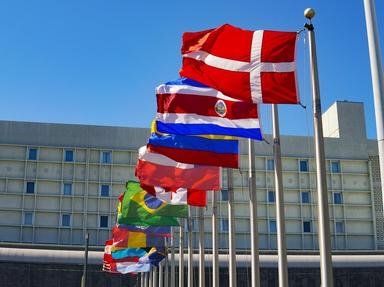Quiz Answer Key and Fun Facts
1. Add on to this red flag in the centre a two-headed eagle in black. Which flag do you then recognize?
2. In this flag you have to add a national pattern of ceremonial cloth, the ruchnik, to the hoist of the flag. Which country shows us this flag in red and green with a symmetrical pattern of red on white at the hoist?
3. In this flag of Bhutan, there is one mythical animal missing. Which one?
4. Yellow and green, this has to be the flag of Brazil. But the blue circle has some extra elements I've not included: a banner with the state motto "ordem e progresso" (order and progress) and a number of stars of different size. What do the size of these stars represent?
5. Yellow with black and white stripes - this must be Brunei. However four symbols in red are missing. Which of these elements is *NOT* represented in red on Brunei's flag?
6. This is part of the flag of the Comoros. One part is missing: a white crescent and four white stars in the green triangle. Why are there four stars?
7. Green, yellow, white, black and red - an unusual combination on national flags. But the missing element is even more rare: an animal in purple (surrounded by ten green stars). Which endemic animal appears on the flag of Dominica?
8. At first glance, this is exactly the flag of Colombia. But add the national coat of arms in the centre, and you get the flag of a different country. Which one?
9. The flag of Eswatini consists (as you see) of red, blue and yellow. But what is missing?
10. A light blue flag to conclude? Of course there has to be more to this flag of Kazakhstan. I've omitted three key elements to this flag: in the centre a sun with 32 rays, just below the sun the outline of an eagle, and along the hoist the national ornamental pattern koshkar-muiz (which could be translated as "ram's horns"). Which colour have all these three elements?
Source: Author
JanIQ
This quiz was reviewed by FunTrivia editor
stedman before going online.
Any errors found in FunTrivia content are routinely corrected through our feedback system.
